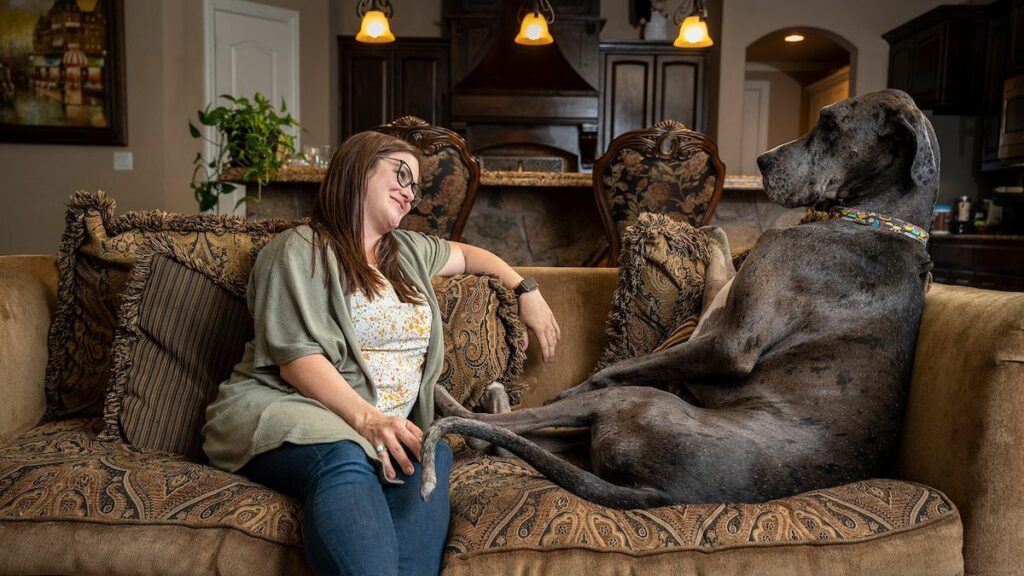Brittany Davis had always wanted a big dog. When she brought home an eight-week-old Great Dane, she got her wish, and then some. She called the puppy Zeus, after the Greek king of the gods. He would grow to be the world’s tallest dog, achieving celebrity status in their hometown of Fort Worth, Texas. “He was the biggest, most expensive gift I have received,” Davis recalls.
Zeus was massive. Pictures of fully-grown Zeus sprawled across a couch next to Davis take a second to process, like images of trick rooms that make proportions warp. On four legs, he was over a meter tall. On his hind legs, he dwarfed Davis. Unaware of his size, Zeus regularly tried to sit on her lap. A home video shows Zeus attempting to perch on Davis’s son’s head during a happy day out.
But just four years after welcoming Zeus, the Davis family said goodbye to him. His giant body was worn out, now missing a leg and wracked with aspiration pneumonia. “It happened so, so fast. He was fine one moment, and the next he wasn’t,” says Davis.
Zeus’s story is heartbreaking for any animal lover. It’s also too common among big dogs. Larger breeds tend to die younger; Great Danes live just 8–10 years on average, according to the American Kennel Club. A lot of factors influence a dog’s lifespan, but body size is a big one. In a 2019 study of dogs that visited U.S. veterinary hospitals, body size was a better predictor of a short life among pet dogs than any other statistic, and researchers have since confirmed that the link between size and lifespan holds up regardless of breed.
Body size vs. lifespan
This relationship between body size and dog lifespan seems stranger when you consider that, looking across species, the opposite is true.
“Typically larger animal [species] live longer, smaller animals don’t live as long, but then we see that opposite with dog breeds,” says Bobbie Ditzler, a veterinarian on the Dog Aging Project at the University of Washington. This means a larger body size alone doesn’t reduce an animal’s lifespan— otherwise, 90-foot blue whales would live like mayflies.


LIMITED TIME OFFER
The perfect gift for the history buff in your life. Give now and get a FREE TOTE BAG.
Veterinarian Silvan Urfer, who also works on the Dog Aging Project, says several competing theories explain big dogs’ short lives. Urfer rules out an easy explanation based on inbreeding. “All modern dog breeds are already very inbred, and there is no reason to think the large ones are somehow more inbred than the small ones,” he says. He also points out that big dogs of a mixed-breed background live, at most, just a few months more than purebreds.
One theory centers on growth. Despite their giant size, Great Danes begin as surprisingly small puppies. “Dogs are not that different in size as newborns,” says Urfer. Between all dog breeds, he says, there is at most a twofold difference in size. But a fully grown Newfoundland lives 9‑10 years and weighs up to 150 pounds. A Chihuahua lives 14‑16 years and weighs six pounds – not much more than a bag of flour. That leaves big dogs with a huge amount of growing to get through.
You May Also Like
This growth burden weighs on big dogs’ cells, says Urfer. As cells divide, protective bits of DNA called telomeres on the end of chromosomes get shorter, and the body produces more oxidative molecules that can damage DNA. As they grow, large dogs, he says, “accumulate damage in their cells for each division, including telomere attrition and … oxidative damage.” This genetic wear-and-tear means big dogs age faster than small dogs. Urfer’s previous research showed large dogs develop age-related cataracts earlier than small dogs. It also increases their risk of other health conditions.
Zeus was diagnosed with bone cancer in his leg when he was just three years old. It’s a diagnosis seen in many bigger dogs. Jack Da Silva, a geneticist at the University of Adelaide, sums up the relationship: For dogs, “the bigger you are the more likely you are to die from cancer,” he says. This pattern is echoed in humans; taller people are at higher risk for almost every type of cancer.
Breaking Peto’s paradox
Look across species and this association breaks down. Larger species not only live longer but also have a lower risk of cancer. This is known as Peto’s paradox. Da Silva theorizes that the paradox only holds when animals have evolved adaptations to having bigger bodies. “It could be that because large breeds have been developed fairly recently, in the last 200 years, that there just hasn’t been enough time for large breeds to evolve better cancer defenses,” he says. Da Silva is exploring whether there is a link between the age of a dog breed and its cancer risk but has been limited by the scarcity of genetic information on so-called ancient dog breeds like the Basenji.
Urfer is less certain of whether an increased cancer risk is solely to blame for big dogs’ shorter lives. A host of small genetic changes drive size variation in dogs. Alterations in a gene called IGF1 accounted for around 15 percent of this variation. When IGF1 is suppressed in mice, they live longer. “It is fair to think that its overexpression in large dogs may have something to do with their faster rate of aging,” says Urfer.
Ditzler also points out that regardless of what makes big dogs sick, they are harder to care for due to their size. For Davis, finding a vet who could accommodate Zeus was an ordeal. “Almost no one had any experience with supporting an animal his size. Most of what we found was actually made for horses, not dogs,” she says.
(Could Fido be our best hope to reverse aging in humans?)
Breeding healthier dogs
Big dog owners can take steps to minimize health risks, says Ditzler. She advocates for early treatment of any health issues and for owners to keep a close eye on their pet’s weight. “Joint issues are a really big deal for large breed dogs,“ she explains. “Once you have a 200-pound dog that can’t get up, that just doesn’t work out for most people.”
Ditzler also says organizations like the American Kennel Club should loosen breed standards for big dogs to reduce body size. “We diversify the genetic pool and then maybe we can avoid some of those diseases,” she concludes.
Davis still wants another Great Dane, when the time is right. “Losing him was like losing a member of my immediate family,” she says. “But I feel so lucky to have loved him for the three years I did, and so blessed to have shared him with the world.”



